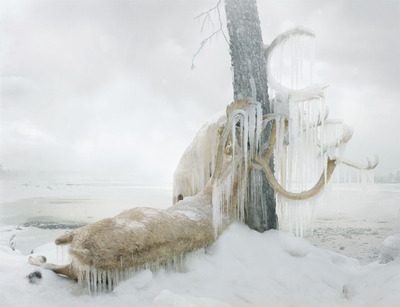Simen Johan: Until the Kingdom comes
David Winton Bell Gallery, Brown University • Providence, RI • brown.edu/campus-life/arts/bell-gallery • Through February 17, 2013

Simen Johan, Untitled #159, 2010, from the series Until the Kingdom Comes,
digital c-print, 63 x 80″. © Simen Johan, Courtesy Yossi Milo Gallery, New York.
Something is not quite right in Simen Johan’s Until the Kingdom Comes. As the title would suggest, this series of photographs and sculptures hints at the apocalyptic; some battle waged and lost. Snakes coil around dead branches, foxes cry, and wolves gambol in a barren terrain. Tendrils of ice drip from the antlers of a frozen stag. A tropical bird devours a toad. The images are elliptical, portentous fragments of a larger doomsday scenario.
The menacing and mysterious prevail. Ominous signs are written into the darkening skies and frozen tundra. Hazy mists cloud the backdrops as a metaphor for uncertain times. It is the stuff of dark fantasy novels—but, then again, maybe not. In an age of global warming, genetic engineering, and artificial intelligence, perhaps such a fantastic landscape is not completely beyond the realm of plausibility. The series probes the indeterminate boundaries between humanity, technology, and nature.
Most eerie are those scenes that carry the residue of the familiar, such as a pair of snow-white owls perched on a picnic table, or a sheep that sits upright like a family dog. They index an absent human presence, leaving viewers to wonder where the people have gone. Indeed, many of the prints feature pairs of animals, as if an ark of creatures, abandoned by humans, were left to an unkind topography. Pallid flamingos entwine. Two moose lock in an eternal tussle. Weirdness reigns.
What is natural? The idea of digital and scientific manipulation is in question. In creating these images, Johan photographed live animals, taxidermy, and roadkill in theatrically constructed sets, contrived further through digital technology. The results are crisp, motionless tableaux, almost lifelike but not quite, skirting the preternatural. These animals live in the “uncanny valley,” a term referring to the aversion caused by robots that veer towards an uncomfortable, yet not quite human, realism. The sheer size of the photographs—nearly life-size—forces a direct confrontation with this strangeness: a startling encounter between human and beast, nature and machine, the artificial and the real.
—Anya Ventura
